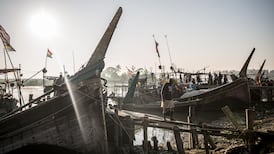The beautiful arched bridge in Mostar was a rare symbol of unity in Bosnia until it was destroyed in the civil war. Now, as Orla Clinton reports, efforts are being made to rebuild it
Of all the bridges ever crossed, the historic Old Bridge in Mostar in Bosnia-Herzegovina always stopped people in their tracks. With its stone crescent shape, its forts and towers on both river banks, the bridge made an astoundingly beautiful impression, especially when seen in the brightness of the light typical of Mostar.
For over four centuries it served as a symbol of Muslim culture until it was destroyed during fighting between Bosnian Muslim and Croat forces in November 1993. For many residents the fall of the bridge represented a loss of identity. It had served as a huge tourist attraction for visitors on their way between Sarajevo and Dubrovnik. It had become a symbol for the state of Bosnia-Herzegovina itself.
Fortunately, residents will soon have their beloved bridge back, restored to its former glory. The reconstruction project is part of a huge economic recovery plan for the city of Mostar which has witnessed major infrastructural developments. It is estimated the bridge will be completed by next year. Already major preparation work has been carried out, including restoration of the structures on both sides of the bridge. All the stone blocks have been retrieved from the Neretva river and lie on the river bank. This month the long-awaited work on the main arch is expected to begin.
The importance of the restoration cannot be ignored. The city of Mostar suffered heavily during the war. Practically all its infrastructure was destroyed, its people torn apart, institutions divided and its historic centre ripped out. Council officials admit the city is still fundamentally divided, but there is almost unanimous agreement on restoring the Old Bridge.
Built in August 1566, the bridge stood as a masterpiece of Islamic architecture. It linked both sides of the Neretva river at its narrowest point. It had several towers, gates, a mosque and craft workshops which attracted a host of artists and travellers.
It was designed by the builder Hajrudin, a pupil of Sinan, the great Turkish architect of the 16th century. The bridge was constructed using square stones with iron hooks cast in lead. A local stone called tenelija was used. Recent geological surveys for the current restoration revealed that this material possesses a remarkable ability to resist weathering. Lighter than chalk stone, it cannot tolerate any kind of artificial intervention, yet is able to withstand adverse conditions. This answered a question which had baffled engineers in 1986. A protective layer was applied that year to the bridge. After an extremely cold winter, the bridge cracked as a result of the applied substance.
Experts have agreed to stick with the same material used in the original bridge. They travelled all over Bosnia-Herzegovina examining other bridges, but none had the same material. In aiming for an exact copy of the Old Bridge, experts also travelled to Turkey to research Ottoman architectural structures.
It was the famed builders and masons from Dubrovnik and surrounding areas who built the Old Bridge, listed as a world heritage site by UNESCO. The restoration will cost over $15 million and is primarily funded by the World Bank, the European Union and the Aga Khan Foundation.
There is an international working group of experts, consultants and advisers, but a Turkish company will carry out the reconstruction of the main bridge.
Today there is little left of the wonder that originally attracted visitors to Mostar.
Instead people now stand on a makeshift bridge marvelling at the reconstruction efforts.
The bridge bears immense importance for the residents of Mostar, who are reminded daily of the war by every bombed-out derelict building, war-scarred facades and the absence of tourists.
Whereas before many historic and cultural monuments testified to an interesting past enriched by the influence of various civilisations and cultures, today these buildings bear only the scars of the past decade.
In a country that has almost three of everything - religions, schools, governments - the Old Bridge is one thing that almost all agree upon. The project has been hailed as a project for all the citizens of the city. However, three separate cultural centres will be constructed in the area around the bridge.
In the divided city of Mostar, the reconstruction of the Old Bridge means a return to normality. It is, for one thing, a symbol of peace and security.
Orla Clinton is a freelance journalist







